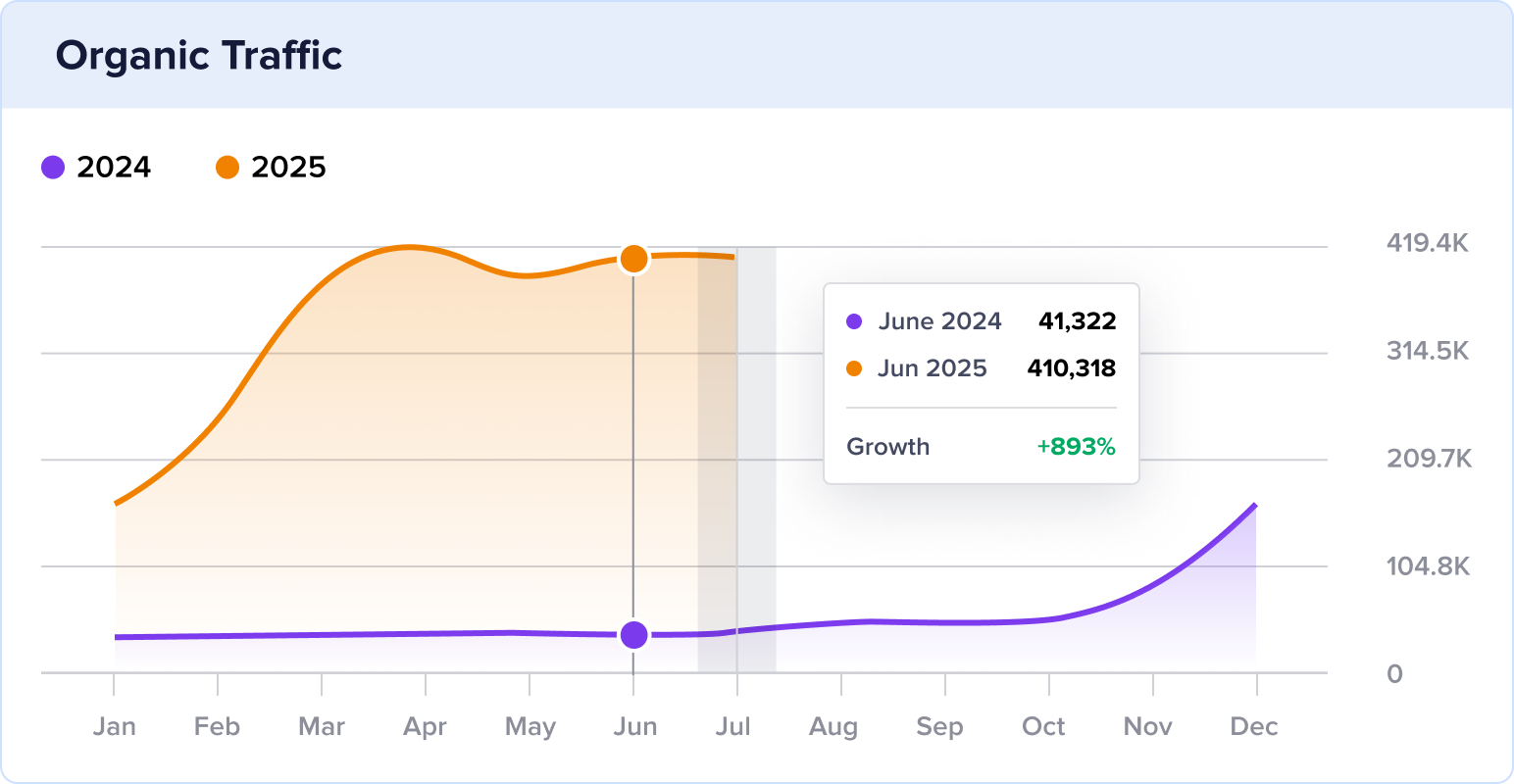How a Latin-Inspired Food Blog Grew Traffic by 926% YoY
https://www.acozykitchen.com/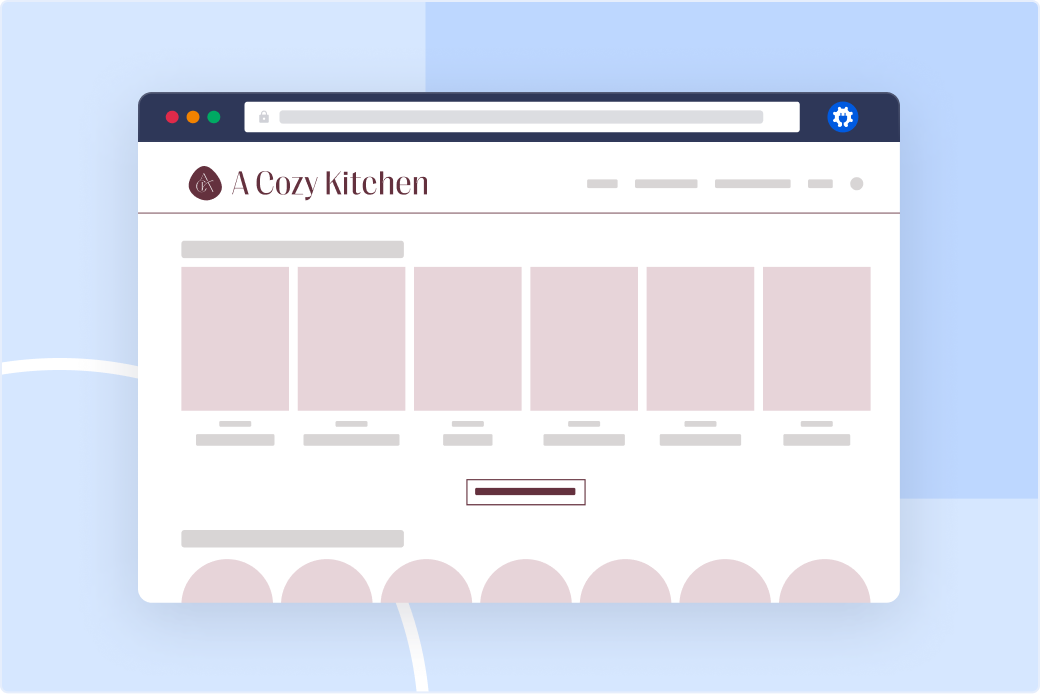
Stats
169.7K to 1.7M Monthly Visits
Industry
Food & Drink
Niche
Food Blog
Reporting Date
April 2024
A Cozy Kitchen is a food blog run by California-based Adrianna Adarme. With Colombian and Peruvian roots, Adarme shares comfort foods inspired by Latin America.
Since launching in 2009, the blog has experienced a massive surge in organic traffic in 2024.
Monthly visits surpassed 1 million and reached a staggering 1.7M by April.
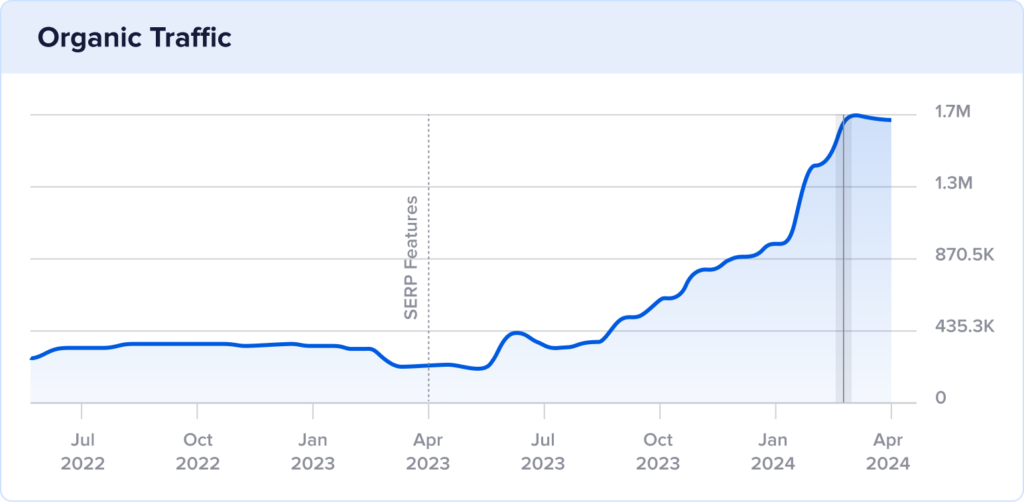
(Had Andarme used paid campaigns to reach this same level of traffic, it would have cost a whopping $1M USD!)
In this SEO case study, I'll dissect the strategies behind A Cozy Kitchen's incredible organic success.
You'll learn how she did it, how to replicate these wins on your website, and the tools and tutorials to make these strategies work for you.
In This Article
The Catalyst: How A Cozy Kitchen Reached 1.7M Monthly Visits
1. E-E-A-T Recipe for Success: Building Trust and Expertise
When running your own blog or website, you hear a lot about high-quality content.
But what does that even mean?
After all, quality can be subjective.
However, in the search landscape, the concept of high-quality content is at the core of ranking.
One model that guides your efforts to create content search engines want to rank is Google E-E-A-T.
Google E-E-A-T stands for Experience, Expertise, Authoritativeness, and Trustworthiness.
It's a framework that Google's Search Quality Raters use to assess the quality and credibility of content.
While not a direct ranking factor, content that demonstrates E-E-A-T tends to perform better in search results.
So, A Cozy Kitchen optimizes for it.
Andarme does this in a few ways:
- Writing in the first person. Andarme frequently shares her own serving preferences, cooking tips, and ingredient alternatives that she’s tested and approved. These details showcase her first-hand experience in the kitchen, cooking the recipes she shares.
- Maintaining a food blog and publishing cookbooks. Andarme has maintained A Cozy Kitchen since 2009. Since its debut, she’s also published two cookbooks. These efforts demonstrate her expertise in the cooking realm.
- Building relationships in the cooking community. Andarme interacts with her audience in various ways. She responds to blog comments, leverages social media to connect with other cooking enthusiasts, and earns the approval of other food bloggers via backlinks. This approach establishes Andarme as an authority in her industry.
- Publishing trustworthy, detailed recipes. Building trust is an ongoing process, but it’s important to have the basics down. Andarme crafts recipes that are accurate, easy to follow, and free of misinformation. This creates a positive user experience that builds trust over time.
- Linking to her author bio on each blog post. As soon as users reach a recipe, they’re greeted by a picture of Andarme and her author profile. Users can click her name to reach the About page, which recounts Andarme’s background and love of cooking. This strategy combines all aspects of E-E-A-T into one user-friendly experience.
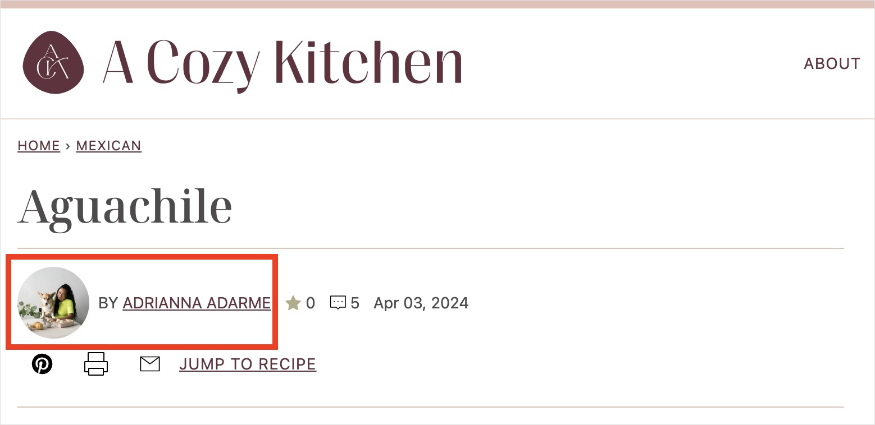
Why this matters:
Imagine searching for a new recipe and stumbling upon dozens of options. With so much content available, how do you decide which recipe to use?
This is where E-E-A-T comes in.
Google prioritizes content that demonstrates E-E-A-T because it signals a higher likelihood of being valuable and trustworthy for users.
These pages will rank higher, making you more likely to click and follow recipes that appear at the top of the SERP.
Content that prioritizes E-E-A-T offers several benefits, including:
- Increased visibility
- Enhanced credibility
- Improved user experience
How to demonstrate E-E-A-T:
Step 1: Leverage your experience.
- Share personal anecdotes and insights related to your topic.
- Showcase your unique perspective gained through real-world experience.
Step 2: Establish expertise.
- Back your content with in-depth research and cite credible sources.
- Offer a balanced perspective by acknowledging different viewpoints within your field.
- Use clear and concise language that demonstrates a strong grasp of the subject matter.
Step 3: Build authority.
- Guest post on relevant websites within your niche.
- Collaborate with other established figures in your field.
- Encourage engagement by responding to comments and fostering discussions on your content.
Step 4: Foster trust.
- Ensure factual accuracy by double-checking information and avoiding misinformation.
- Be transparent about your qualifications and any potential biases.
- Provide clear value to your audience by solving their problems or offering actionable advice.
Step 5: Highlight author bios.
- Include your credentials and relevant experience that establishes you as an authority.
- Briefly touch on your passion for the topic and what motivates you to share your knowledge.
- Link to your social media profiles or website to showcase your online presence and expertise.
Tools for Google E-E-A-T:
Building a strong E-E-A-T profile requires consistent effort across various aspects of your content strategy.
Fortunately, tools are available to streamline the process, specifically when crafting compelling author bios.
My favorite tool is All in One SEO's Author SEO addon.
This feature simplifies the process of writing and displaying informative author bios in WordPress. You can easily add credentials, upload a profile picture, and share your topics of expertise.
It’s super easy to use, and I love that it implements author schema markup automatically for you. (We’ll get more into schema markup next, but spoiler alert: it’s important!).
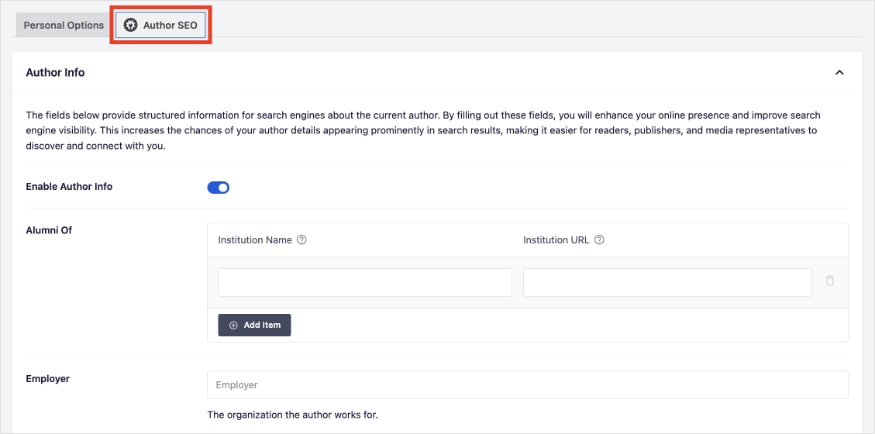
Next, let’s look at some technical SEO techniques Andarme uses to get the attention of search engines and users.
2. Schema Markup Secret Sauce: From Recipes to Rich Results
While E-E-A-T focuses on building authority and trust with users, schema markup is all about communicating effectively with search engines.
Think of it as a special language that helps search engines understand what kind of content you're offering. There are several types, and each communicates important details about your page.
For example, A Cozy Kitchen frequently uses recipe schema markup on its blog posts.
Recipe schema markup allows you to set attributes like:
- Dish name
- Cooking time
- Serving size
- Nutritional information
In turn, search engines understand exactly what goes into your dish. They can also use this information to generate a recipe snippet on the SERP.
Recipe snippets display additional details like some of the attributes mentioned above.
Take a look at the example below.
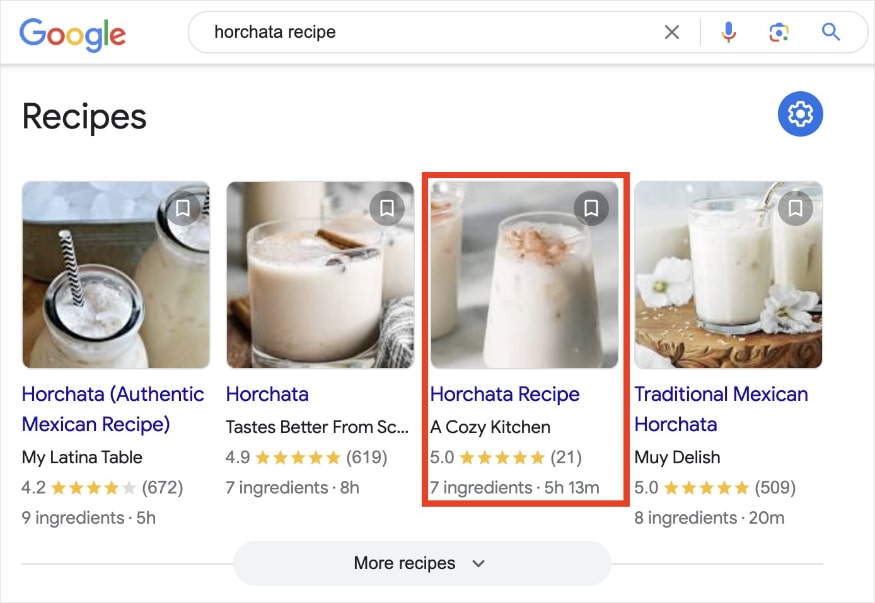
This page not only ended up in the recipe carousel but also tells users how many ingredients are required and how long it takes to cook.
Pretty enticing to click, right?
Users think so, too.
According to SEO statistics, rich snippets get 58% of all clicks!
Why this matters:
Rich results are like supercharged search listings.
They work overtime to grow your clickthrough rate (CTR) and drive traffic to your site.
And for food blogging, they’re essential.
Food is a competitive industry, and finding ways to stand out on the SERP is critical.
Recipe snippets are a great way to achieve just that.
For A Cozy Kitchen, Andarme’s optimizations have been fruitful. The blog ranked for 22.7K keywords with recipe snippets in April.

How to implement recipe schema markup:
This tutorial shows you how to set recipe schema in WordPress, but here’s a quick overview of the process:
- Install a schema generator plugin.
- Select recipe schema markup.
- Configure your recipe details.
- Save your changes.
Tools for recipe snippets:
The AIOSEO Schema Generator is one of the easiest schema markup tools to use. You literally pick your schema type from a catalog.
Just locate and click recipe.

Then, you can set as much information as you want in the settings.
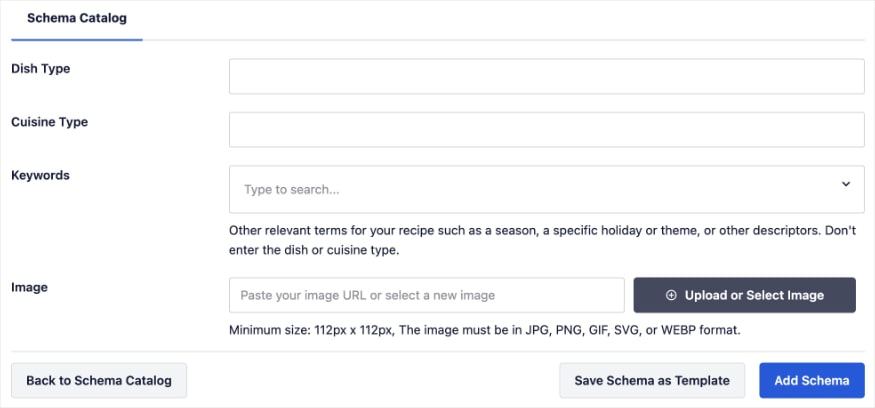
AIOSEO will properly format and apply the recipe schema for you.
Now, let’s see how customer ratings and reviews are earning A Cozy Kitchens stars on the SERP.
3. Star Power: Leveraging User Ratings and Reviews
In today's digital age, social proof reigns supreme.
And there's no better way to showcase it than through positive user ratings and reviews.
A Cozy Kitchen understands the power of social proof.
At the end of each blog post, Adarme includes a call to action (CTA) inviting readers to rate and comment.

This approach works, considering how many recipes have several reviews.
(Notice how Adarme also boosts engagement by responding to comments. This is a great way to build real connections with your readers.)
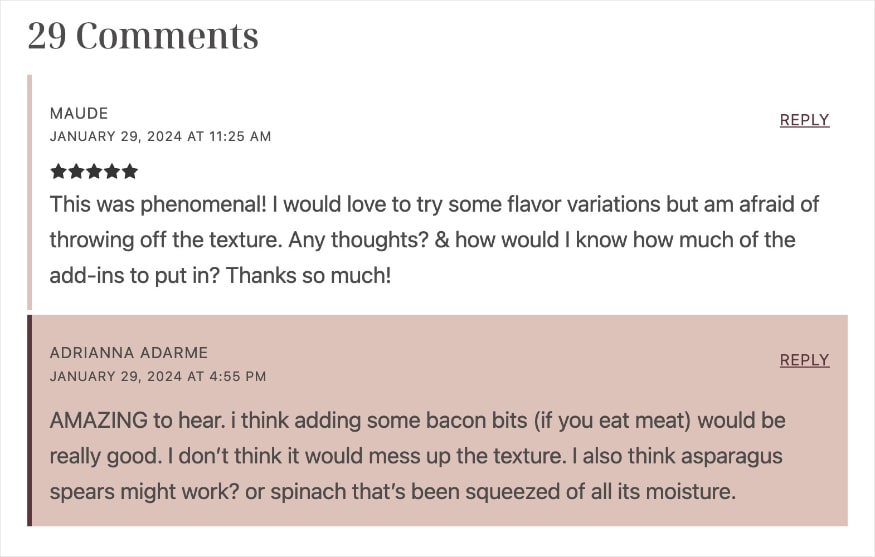
As for behind the scenes, Adarme uses another type of schema markup to get these ratings on the SERP: AggregateRating schema markup.
AggregateRating schema markup is a subset of the aforementioned recipe schema (among others).
It allows search engines to compute a recipe's average rating and potentially translate this information into stars on the SERP.
Here’s what one looks like in search results:

This recipe has an average rating of 4.8 based on 4 votes.
It also features the cooking time, which was set in the recipe schema markup.
In April, A Cozy Kitchen ranked for 91.4K keywords with review snippets.

Why this matters:
Social proof influences user behavior.
Positive customer ratings and reviews act as a digital thumbs-up, offering potential readers valuable insights from real people.
Review snippets help you to:
- Build trust.
- Get more clicks.
- Increase organic traffic.
How to set review schema markup:
As mentioned earlier, you can use a rich snippets schema generator to to add schema markup on your site.
You can also add it manually.
This tutorial shows you how to add schema markup without a plugin. It uses JSON-LD and requires basic coding knowledge.
As for getting the code, you can use either of these tools:
Tools for review snippets:
For now, AIOSEO supports rating schema for products, movies, and software.
However, as an exclusive sneak peek for Trends readers, I’m happy to confirm that it’s in the works for recipes. (Food bloggers, rejoice!)
This is going to be a great addition to the plugin, and personally, I can’t wait. I see a lot of food blogs optimizing for review snippets, and frankly, it’s necessary in 2024.
Review snippets are so powerful, especially for food bloggers and eCommerce.
And with the upcoming feature addition to AIOSEO, they’ll be easier than ever to get.
4. People Ask, Adarme Answers: How-Tos and FAQs Dominate the SERP
Today's search engines anticipate user intent and go beyond basic results to offer a rich search experience. One powerful feature is Google's People Also Ask (PAA) box.
This section appears near the top of the SERP and offers related questions to the user's initial search.
Here’s an example:
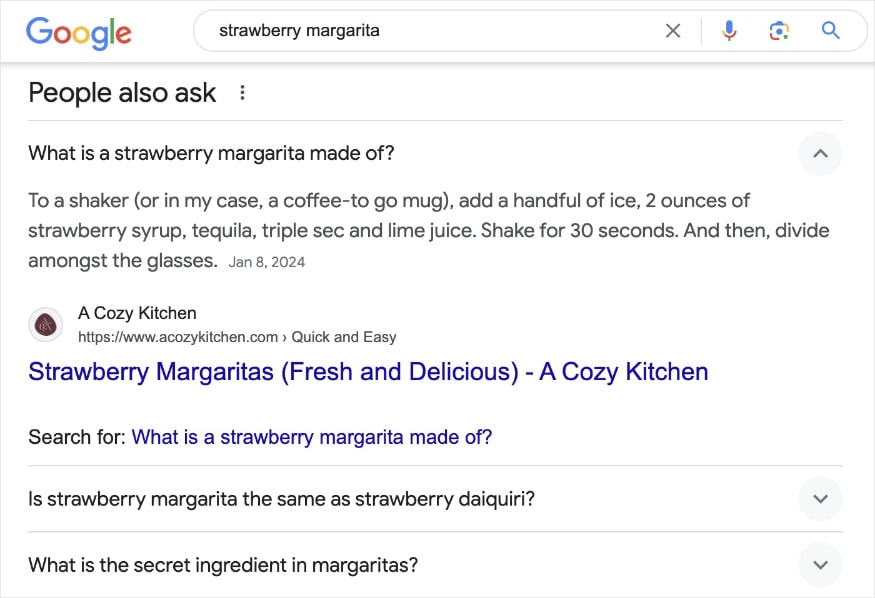
A Cozy Kitchen understands the importance of the PAA box and leverages it strategically to amplify its visibility.
Andarme does this by:
- Writing FAQs at the end of each recipe. (And adding FAQ schema markup.)
- Including how-to steps in each blog post. (How-to schema for this one, too.)
- Understanding and fulfilling search intent.
These optimizations have been effective, considering how A Cozy Kitchen ranked for 4.6K keywords in Google’s PAA box in April.
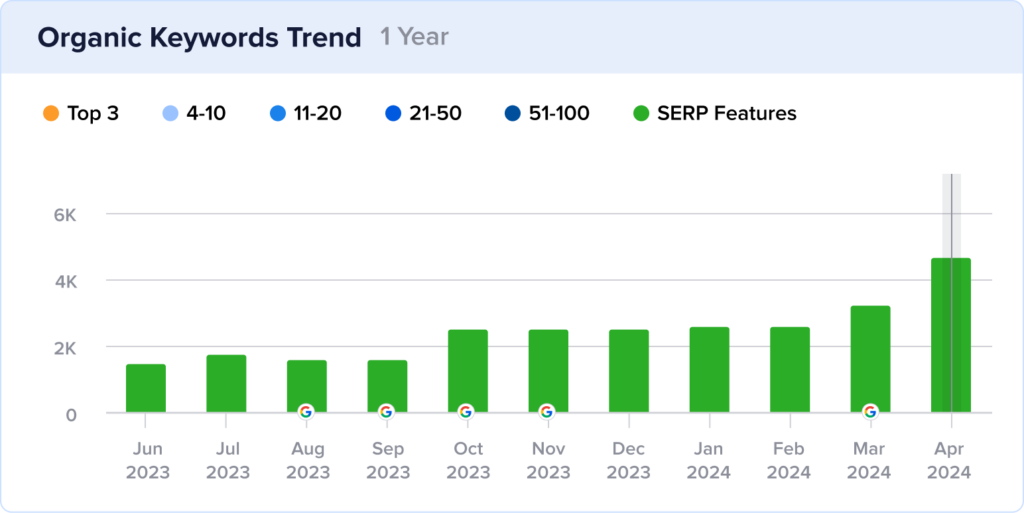
Why this matters:
The PAA box is prime real estate on the SERP.
It helps users find answers quickly, creating a streamlined search experience.
Sources in the PAA box are also considered more trustworthy, which can support a positive brand image.
How to rank in Google’s People Also Ask:
This article shows you how to optimize for the Google PAA box.
I’ll recap some of the most important steps here:
- Perform keyword research and focus on question-based keywords.
- Write people-first content that meets search intent.
- Implement FAQ schema markup. (HowTo schema is another option, depending on your content.)
- Analyze competitors ranking in the PAA box.
Tools for PAA rankings:
AIOSEO makes it a breeze to optimize for Google’s PAA box.
You can use FAQ blocks in WordPress that add FAQ schema for you.

You can also add HowTo schema in just a few clicks.
Simply select How To from the Schema Catalog. You’ll then reach user-friendly fields where you can type in each step.

Talk about easy!
Standout SEO Wins
In addition to high-quality content and technical SEO, Andarme has mastered using social media to grow her audience.
Let’s explore some of her social media techniques that contribute to her overall SEO success.
Social Media Fuels Organic Success
Andarme leverages several social media platforms to reach her audience on all their favorite corners of the internet.
She is present and active on Facebook, YouTube, Pinterest, and TikTok.
Instagram is her most popular social channel, with 604.9K followers.
On Instagram, Andarme posts almost exclusively reels (videos).
What’s interesting is that these videos not only appear in the app itself but also rank in Google.

This approach doubles the wins from her content creation efforts.
- She creates an engaging channel on Instagram.
- She ranks in traditional search engines like Google.
Andarme is also very responsive to user comments on her posts.
This open line of communication has become a cornerstone in creating a loyal audience for A Cozy Kitchen.
Tool: AIOSEO can help you optimize and share your content across all your favorite social media platforms. With the Social Media Integration, you can connect your WordPress site to 11 social networks.
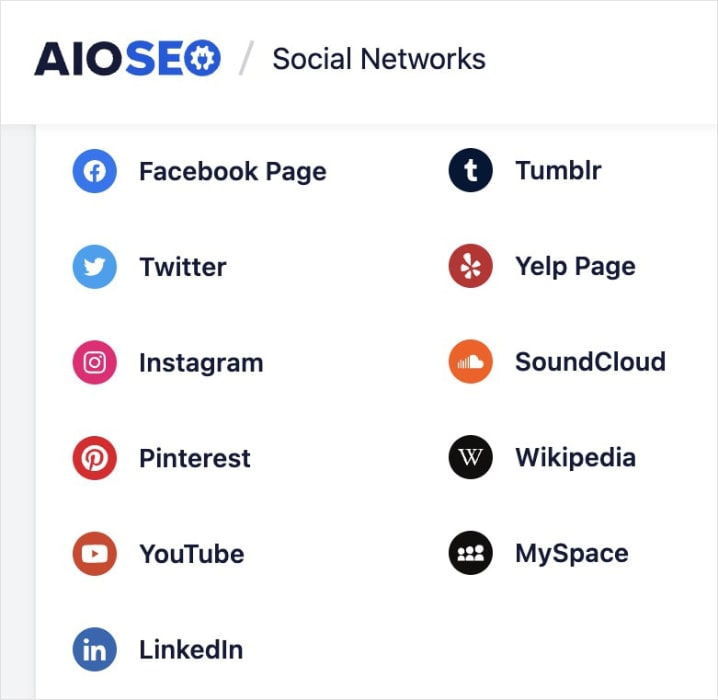
Takeaways
Let’s take a step back and see how A Cozy Kitchen’s wins can help grow your website’s traffic.
We’ll also look at which areas could be improved.
Top 3 Strategies to Emulate
- Optimize for Google E-E-A-T. Focus on building trust and expertise (E-A-T) to establish yourself as a reliable source in your niche. Craft content that showcases your knowledge, share personal anecdotes, and back your information with credible sources. This approach positions you as an authority figure readers can trust.
- Leverage schema markup to win rich snippets. Schema markup helps search engines understand your content. And the easier it is for them to understand your web pages, the better your chances of ranking. Schema markup can also help you unlock rich snippets, which have high clickthrough rates.
- Think outside of organic search. Branch out and leverage other channels to grow your brand awareness. Social media is a powerful tool for fostering a community and driving traffic to your site. You can promote content across several platforms to read a wider audience and engage with your followers wherever they are.
Bottom 3 Strategies to Reconsider
- Excluding internal links on pages. Internal links connect different pages on your website, creating a user-friendly experience. They also help search engines understand your website's structure. Some of A Cozy Kitchen's pages don't have any internal links, and this oversight can hinder the navigation process. For your site, I'd recommend using an internal linking tool, like Link Assistant, to streamline your linking efforts.
- Overlooking image alt text. For the most part, A Cozy Kitchen does a great job optimizing its images. However, sometimes it misses an opportunity to write descriptive alt text. Alt text improves accessibility for visually impaired users and helps search engines better understand your images. You can use the Image SEO tool to write alt text automatically.
- Exceeding meta title character limits. Character limits ensure your meta titles are complete and informative. When you exceed them, you'll get truncated titles, which are a less-than-ideal user experience. Keep your meta titles concise and under 60 characters. You can run your meta titles through a SERP preview tool to make sure they fit on the SERP.
Steal Our Winning SEO Strategy: A Checklist for Your Website
Download A Free SEO Checklist
Access our comprehensive SEO Checklist with a single click. We'll deliver it straight to you, putting actionable items with SEO tools and tutorials right at your fingertips.
Enter your name and email to download a free SEO checklist.
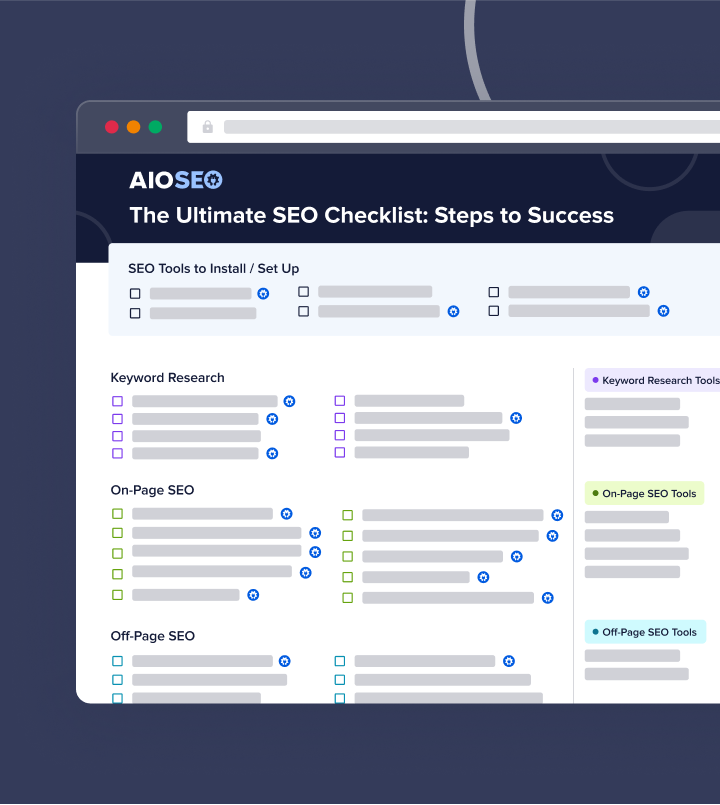
Replicate A Cozy Kitchen’s Success With AIOSEO
A Cozy Kitchen's growth journey serves as an SEO recipe for success.
But what if you could skip the guesswork and replicate this winning formula with ease?
AIOSEO empowers you to rank higher and get results without the hassle.
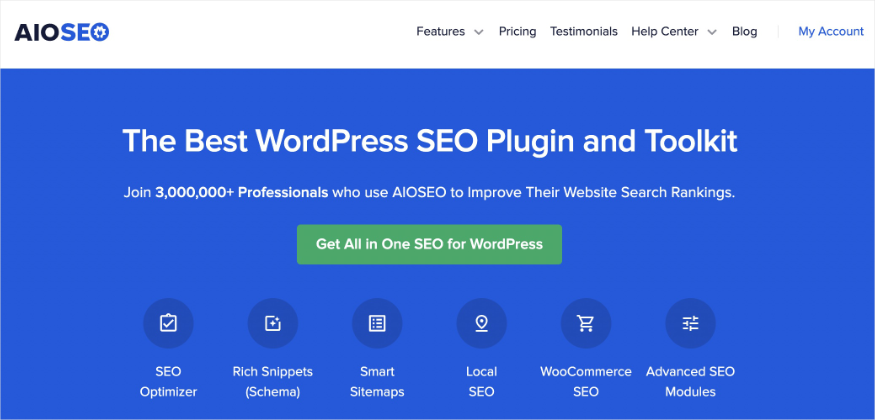
AIOSEO is the best WordPress SEO plugin on the market. It has over 3 million users and thousands of 5-star reviews. You’ll get a suite of beginner-friendly tools that make optimizing your website for users and search engines easier than ever.
Here are some of the most popular tools:
- Author SEO: Create powerful author bios that showcase your experience and expertise. This addon aligns your content with Google E-E-A-T guidelines and helps readers trust what you’re sharing.
- Rich Snippets Schema: Win more rich results with AIOSEO’s user-friendly Schema Generator. Just pick the schema type you want, and we’ll format the structured data properly for Google.
- FAQ Blocks: Add FAQs to your content to increase the likelihood of appearing in Google’s People Also Ask box. These results help boost brand awareness and increase clickthrough rates.
- Social Media Integration: Connect your favorite social media platforms to your site and share content with your audience. Available integrations include Facebook, Instagram, Twitter, LinkedIn, Pinterest, YouTube, and more.
- Link Assistant: Get link suggestions, edit anchor text, and add internal links to your content in just 1 click. Link Assistant helps you effortlessly build a better linking strategy.
- Image SEO: Turn on automatic image alt text and title attributes with a single click. You’ll save time from manual entries while helping users and search engines understand your images.

